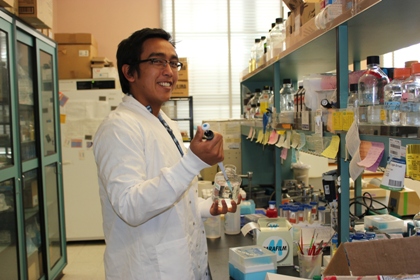
Cheyne Kurokawa, Fall 2012 Ph.D. Student, Mayo Graduate Clinic, Virology and Gene Therapy
By Kari Szakal
Cheyne Kurokawa never thought obtaining a Ph.D. was possible. Although he had been engaged in school work and was interested in his classes, it wasn’t until Cheyne was in a virology class that he felt the first stirrings of academic curiosity and excitement. Thinking back, Cheyne commented that “the moment in research that really clicked for me was when I first dissected a fly heart and looked at its structure. It was cool because I made the genetic crosses and did the fluorescent staining and saw that science was actually real, and not magic.” Cheyne joined the MBRS program in August 2011, expecting to graduate in May 2012. Even with such a short amount of time in the program, Cheyne conducted research with Dr. Sandy Bernstein, will earn his B.S. in Biology and accepted admission into the Ph.D. program in Virology and Gene Therapy at the Mayo Graduate Clinic. Cheyne attributes his success to the MBRS program workshops, graduate program application strategies, and steady guidance from MBRS, as well as the support he was given to develop his research project and attend conferences, which are markers of a great Ph.D. candidate.
Of all of his accomplishments, Cheyne is most proud of his acceptance into a Ph.D. program: being offered admission to prestigious graduate programs was an affirmation of his desire pursue a career in research and academia. Cheyne currently works under the auspices of Research Assistant Professor Dr. Girish Melkani, who collaborates with Dr. Bernstein on the molecular genetic analysis of muscle gene and protein function during Drosophila development. Cheyne’s project uses fruit flies to examine the heart defects often associated with Huntington’s Disease. Cardiac failure is the second leading cause of death in patients with Huntington’s though research being done has been limited and preliminary. Cheyne hopes to complete his Ph.D. and postdoctoral work with the intention of staying within the academic field later in life and helping students like himself realize their potential in academia. Cheyne also hopes to continue producing scientific research and creating new knowledge in science. Reflecting on his experience in the program, Cheyne’s parting words of advice to future members of the program, “Listen to MBRS! The program knows how to help students and they support/advise a lot of students.”
If you would like to learn more about what MBRS can do for you, please visit: https://sci.sdsu.edu/imsd/ , stop in at GMCS 322c, or email Jessica at jnombrano@mail.sdsu.edu